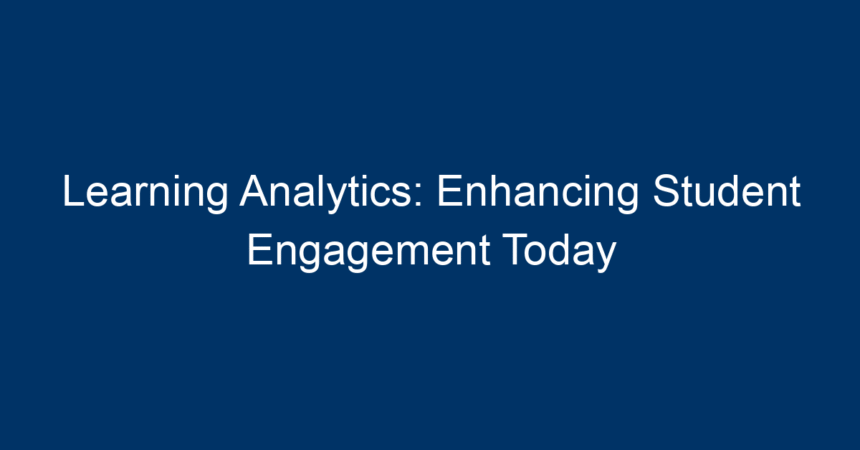In today’s rapidly evolving educational landscape, learning analytics stands out as a pivotal tool for enhancing student engagement and academic performance. With the wealth of data generated by educational activities, institutions can harness these insights to foster an environment that boosts student motivation and success. This article explores how learning analytics can transform the educational experience, driving student engagement and ultimately leading to better outcomes.
What is Learning Analytics?
Learning analytics refers to the measurement, collection, analysis, and reporting of data about learners and their contexts. By leveraging this information, educators can understand how students learn, identify areas of struggle, and thus tailor their teaching methods effectively.
The field combines various disciplines such as data science, education, psychology, and technology, making it an interdisciplinary approach to improving educational experiences. Importantly, learning analytics not only focuses on metrics but also emphasizes actionable insights that can lead to improved student engagement.
The Importance of Student Engagement
Engagement is a critical factor in effective learning. Engaged students are more likely to retain information, participate actively in discussions, and show better overall performance. Research has shown that emotional, behavioral, and cognitive engagement corresponds directly to students’ academic success.
Implementing learning analytics systems provides educational institutions with invaluable insights into student engagement levels. By analyzing data such as attendance, participation in online discussions, and assignment submissions, educators can form a clearer picture of how engaged their students are and where interventions may be necessary.
Key Components of Learning Analytics
To maximize the potential of learning analytics, it’s crucial to understand its key components:
1. Data Collection
The foundational step in leveraging learning analytics lies in gathering comprehensive data. This includes:
- Course completion rates
- Assessment scores
- Interaction logs
- Feedback surveys
Data collection should respect student privacy while ensuring that it is representative and useful for analysis.
2. Data Analysis
Once data is collected, the next step is analysis. Here are some methods used:
- Descriptive Analytics: Summarizes historical data to identify trends (e.g., average grades).
- Diagnostic Analytics: Explores why certain phenomena occur (e.g., low performance).
- Predictive Analytics: Uses historical data to make predictions about future performance (e.g., identifying at-risk students).
3. Data Interpretation
Merely having data isn’t enough; interpreting the results accurately is key. Educators must connect data patterns with students’ learning behaviors, identifying not just indicators of low performance but also uncovering insights that reveal the factors driving student engagement.
4. Actionable Insights
Ultimately, the goal of learning analytics is to turn insights into actionable strategies. For example, if data indicates that students disengage after a specific lecture style, educators can adapt their teaching methods accordingly. Additionally, using predictive models can help identify at-risk students early, allowing for timely support.
Enhancing Student Engagement Through Learning Analytics
Personalized Learning
One of the most significant advantages of learning analytics is the ability to facilitate personalized learning experiences. By analyzing individual student data, educators can tailor the curriculum to meet specific needs, adapting instruction to match students’ unique learning styles and paces. Personalized learning not only fosters engagement but also empowers students to take ownership of their educational journeys.
Early Intervention
Learning analytics serves as a powerful early warning system. By keeping track of various engagement metrics—like participation rates in discussion forums or timely submission of assignments—educators can identify at-risk students before problems escalate. Implementing support strategies early leads to increased retention rates and improved academic outcomes.
Feedback Loops
Feedback is essential for learning. Learning analytics allows for the creation of real-time feedback loops, where students can receive immediate insights into their performances. This timely feedback can motivate students to improve and stay engaged, as they are aware of their progress and areas needing attention. When students see how their efforts are directly correlated with their success, they are more likely to remain engaged.
Enhancing Collaborative Learning
Data analytics also enhances collaborative learning by analyzing how students interact with peers. Understanding collaboration patterns helps educators design activities that encourage student interaction, leading to deeper engagement. Moreover, analytics can help in forming effective groups by assessing compatibility and past performance.
Challenges in Implementing Learning Analytics
While the benefits of learning analytics are immense, there are certain challenges associated with its implementation:
Data Privacy Concerns
With data collection comes the responsibility of safeguarding student information. Institutions must ensure compliance with regulations such as GDPR and be transparent about how data is being used. Building trust with students and parents is essential for successful implementation.
Integration with Existing Systems
Integrating learning analytics platforms with existing Learning Management Systems (LMS) can be complex. Institutions must invest in seamless technologies that can harmonize with their current systems to ensure accurate data collection and reporting.
Training Educators
To maximize the benefits of learning analytics, educators must be adequately trained. It is vital to foster a culture that values data-driven decision-making, where educators feel confident in interpreting analytics and applying these insights in their teaching.
Concluding Insights
The future of education increasingly hinges on the effective use of learning analytics. By understanding student engagement and employing data-driven strategies, educational institutions can foster enriching environments that promote academic success.
Actionable Steps for Educators:
- Start Small: Begin with easy-to-analyze metrics like attendance and engagement in discussion forums.
- Foster Feedback Culture: Encourage students to provide feedback on course structures, using this data to refine teaching methods.
- Invest in Training: Ensure educators are well-equipped to interpret analytics and use the insights effectively.
- Prioritize Data Privacy: Establish and communicate clear data protection measures to build trust.
- Collaborate with IT: Work with technology teams to streamline data integration from various systems for more comprehensive insights.
By embracing learning analytics, educators can not only enhance student engagement today but also lay the foundation for a more effective, personalized learning experience in the future.




